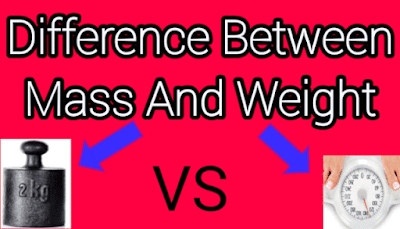Mass and weight are two commonly used terms in Physics. In the beginning, most of the students think that mass and weight are synonyms of each other. It is not a fact. Because mass and weight are two different terms. Mass is the property of a body and weight is the force acting on a body. To clearly understand the difference between mass and weight, we have to take an overview of different parameters.
Difference Between Mass and Weight
Mass and weight are different from each other based on different parameters. Here, we compare these parameters one by one.
1. Difference Between Definitions of Mass and Weight
Mass is known as the property of matter and with the help of it, we can easily measure the strength of the gravitational attraction of a body. On the other hand, weight is the amount of force that is acting on the body. This force can act on a body either due to gravity or any kind of reaction force.
2. Difference Between Their Quantities
As we know that there are two types of physical quantities. First is the scalar quantity and the second is the vector quantity. There is also a clear difference between vector and scalar quantities. The mass of an object is a scalar quantity. Its reason is that to measure the mass of an object, we just need magnitude and unit. On the other hand, the weight of an object is a vector quantity because if we want to measure it, we need magnitude, unit, and direction.
3. Difference Between Values of Mass and Weight
We can also observe a clear difference between the values of these two terms. The value of mass is the same at all places because it doesn’t depend upon gravity. Therefore, we can say that the mass of an object can never be zero. Conversely, the weight of an object depends upon gravity. Therefore, it has different values in different places. For example, the weight of an object has two different values on Earth and Moon due to the difference in the values of gravity. On the other hand, the mass of an object remains the same on the Earth as well as on the Moon.
4. Different Values at Different Locations
If we change the location of an object, we can’t see any kind of difference in the mass of the object. On the other hand, if we change the location of an object, we can see a definite difference in the weight of an object. If we go higher and higher, the value of gravity will decrease. As a result, the weight of an object also decreases. Conversely, if we are decreasing our altitude, the value of gravity will increase and we see a definite increase in the value of the weight of an object.
5. Difference Between Measuring Instruments of Mass and Weight
It is a fact that if we are going to measure anything, we require a measuring instrument. Similarly, if we are going to measure the mass of an object or the weight of an object, we require measuring instruments. As these are two different terms, therefore, there require two different measuring instruments to measure them. We can easily measure the mass of an object with the help of an ordinary balance. On the other hand, to measure the weight of an object, there requires spring balance.
6. Difference Between Their Units
A standard for the measurement of an object is known as a unit. To measure the mass and weight of an object, we have to use two different units. The SI (System International) unit to measure the mass of an object is Kilogram and it is abbreviated as Kg. On the other hand, the SI (System International) unit to measure the weight of an object is Newton and it is abbreviated as N.
7. Difference Between Their Formulas
In Physics, we can’t deny the importance of Mathematics because there require mathematical formulas to measure different terms. We measure the weight by using the following formula;
- F = ma
- m = F/a
We can easily measure the ‘m’ of an object if we know the values of the force and acceleration of this object. The formula to measure the weight of an object is also given below;
- W = mg
We can easily measure the ‘w’ of an object if we know the values of mass and gravity.
With the help of these formulas, it is also possible for us to convert the mass of an object into weight and vice versa. For example, if the mass of an object is 10Kg, we can convert it into weight by using the formula W = mg;
External Factors Affecting Mass and Weight
As we know that mass is an intrinsic property of an object. That’s why there is no external factor that can affect the ‘m’ of an object. On the other hand, the weight of an object depends upon the mass of that object. Therefore, the force of attraction can easily influence the value of the weight of that object. That’s why if you are going to measure the quantity of an object, you should use mass rather than weight. Its reason is that the mass of an object remains the same at all places, whereas, the weight of an object changes by changing the altitude. You may also like to read about the difference between distance and displacement.
Why We Use Mass in The Formula to Measure Weight?
Most of the students think that due to lots of differences between these two terms, why we are still using mass in the formula to measure weight. It answers that the weight of an object is due to the gravitational force that attracts a body. If the mass of an object is very small, the value of the gravitational force will also be small. That’s why we can observe that a fog particle remains suspended in the air. Due to this reason, we must use mass in the formula of the weight. Another reason is that mass is the functional property of the matter and weight is known as the consequence of that property.
To sum up, we can say that these two terms depend on each other. The greater the value of the mass, the greater will be its weight, and vice versa. The main difference between the two terms is that mass is a constant quantity, whereas, the weight of an object changes with the change in altitude.
Tips to Calculate Weight from Mass
After knowing the difference between these two terms, you can easily calculate the weight from the mass. Some essential tips to calculate weight from the mass are given below;
Tips to Calculate the Weight
To calculate the weight from the mass, you should follow these simple tips;
♦ You should use the formula ‘W = mg’ to convert the weight into the mass. Here, weight is also known as force. Therefore, we can write the formula ‘W = mg’ as ‘F = mg’.
♦ Secondly, we have to figure out the mass of the object. Its reason is that we have to put the value of the mass in the equation to find ‘w’.
♦ In the equation ‘W = mg’, ‘g’ is known as gravitational acceleration. Therefore, to calculate the ‘w’ of the object, you should also figure out the value of ‘g’. The value of ‘g’ is ‘9.8 meters per second square.
♦ At last, by plugging the values into this equation, you can easily find out the value of the weight of an object.
Sample Problem to Calculate Weight
After knowing the steps to calculate the weight of an object, you can easily solve the problem to calculate it. Here, we will discuss the steps to calculate the weight of an object. If an object has 200 kilograms of mass, calculate the ‘w’ of the object. The steps to calculate this problem are given below;
Solution:
♦ Mass of the object = 200 kg
♦ Gravitational acceleration = g = 9.8m/s2
♦ Formula: W = mg
♦ W = 200*9.8
♦ W = 1960N
Tips to Catch the Mistakes
Some people make some mistakes while solving these problems. You can easily catch mistakes in your problem by following these simple steps;
♦ You should not mix these two terms. For this reason, you just remember that mass remains constant, whereas, weight changes due to the change in gravity.
♦ You should use scientific units while solving this problem. For example, the unit of mass is ‘kg’, the unit of gravitational acceleration ‘g’ is m/s2 and the unit of weight is ‘N’.
♦ The answer to this question should be in ‘N’ because the unit of weight is ‘N’.








2 thoughts on “Difference between Mass and Weight”